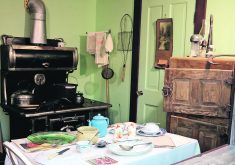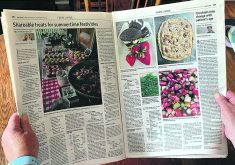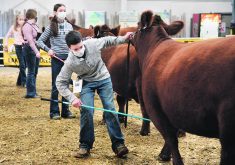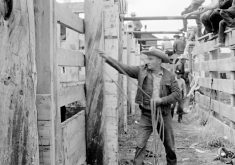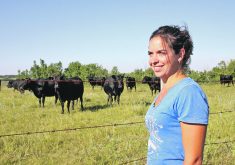A retired farmer who lost her fight to save some of what she calls British Columbia’s best farmland says an important lesson Canadians need to learn is reflected in the title of a 40-year-old documentary.
“It came from a quote I had said,” said Ruth Veiner.
Related stories:
- ‘They can’t stop us’: farmers dig in on Site C
- VIDEO: B.C. to continue with Site C dam project; farmers dismayed
- <a href="h
- Site C decision rewards renegades
Read Also

Know what costs are involved in keeping crops in the bin
When you’re looking at full bins and rising calf prices, the human reflex is to hold on and hope for more. That’s not a plan. It’s a bet. Storage has a price tag.
“I look at this land not as being given to me by my parents but borrowed from my children.”
This Borrowed Land is being shown online for free this month as part of Perspectives from the Prairies, a year-long series of National Film Board films celebrating the 100th anniversary of The Western Producer.
Veiner, 85, is among the last people still alive who took part in the 28-minute documentary, which was released in 1984. It looked at women involved in farming near the Peace River Valley in northeastern British Columbia as they went about their lives under the looming threat of the Site C hydroelectric dam.
After decades of back-and-forth decisions by the provincial government and B.C. Hydro, construction finally began in 2015 on what has since ballooned into a troubled, $16 billion project. Workers have completed an earth-fill dam on the Peace River near Fort St. John, B.C., that is more than one kilometre wide and about the height of a 20-storey building.
It will create an 83-km-long reservoir that is expected to begin filling this year, flooding farmland that includes Class 1 soil. Veiner said land in the valley near the river has a mild microclimate that can grow crops such as melons that typically can only be raised much further south in B.C.
Ken Boon, president of the Peace Valley Landowner Association, spent years fighting Site C. Much of his river bottom and bench land was expropriated for the project, and he was also affected by the realignment of a nearby highway and the construction of a new bridge for Site C.
“This is land that had been in my wife’s family since the ’40s.… It was just a beautiful mix of wilderness and farmland and the river flowing through the middle,” said Boon.
“That’s all going to be changed and ruined, and yeah, at various times throughout this fight, it brings a tear to your eye to just think of what we had and what we’re losing. But life goes on, and so one has to just adapt.”
The same story is being played out throughout the valley, he said.
“So, yeah, some pretty major impacts on the farmland, and of course, it’s the very best farmland in this whole country on the B.C. side of the Peace here.”
Veiner said much of the land was never cultivated because of the uncertainty over Site C. She spent decades fighting the project, which she feared could negatively impact the climate of the Peace region even for farmers like herself whose land will not be flooded.
Site C is expected to generate about 5,100 gigawatt hours of electricity per year, which is equivalent to powering about 450,000 homes. Although it was described in 2010 by then-B.C. Premier Gordon Campbell as a clean energy project that is essential for the province’s economic and ecological future, Veiner said much of its electricity will likely be used to create liquified natural gas for shipment to Asia.
B.C.’s decision to prioritize a controversial hydroelectric project over crop production is yet another example of how Canadians have forgotten they are borrowing land from future generations who will need it to grow food, said Veiner. As a former board member with the National Farmers Union, she learned about what was happening to producers in other parts of the country.
“Right across Canada, multinationals were taking over family farms in disregard for productive land — for digging for coal, for digging for uranium, for digging for whatever, for putting pipelines in. There was just a disregard for our food-producing land, and if the country ever gets to the point where it can’t produce its own food, we are in bad shape.”
This Borrowed Land demonstrated the commitment of women to what could sometimes be a difficult way of life as they experienced what could also be an idyllic rural existence as farmers, said NFB collection curator Camilo Martin-Florez. The film was made by the NFB’s Studio D, which was the world’s first publicly funded feminist film studio.
The studio was formed in 1974 and earned more than 130 awards, including three Oscars, before closing in 1996. Martin-Florez selected the documentary for Perspectives from the Prairies not only in honour of International Women’s Day on March 8, but also to mark the 50th anniversary of Studio D.
The documentary was shot in 1983 and it was the last project for the NFB by director Bonnie Kreps, said her daughter, Lise, who also worked on the project.
“It was partly about the lives of women, in particular on family farms, because my mother was a feminist filmmaker. She’s 87 now and lives in a care home, but it was very important to her to profile the lives of women in various places and in various circumstances.”
Lise was impressed by the women in This Borrowed Land.
“I’ve never lived on a farm, so I can’t speak for them, but I can certainly say that the women in the film show incredible gravitas — which is the obvious word, but that sounds too trite — but they have such integrity and such dedication, and they work so hard.”
Apart from a busy life as a farmer who raised several children, Veiner was also a schoolteacher as well as an activist.
“I look back in my journals and I just get tired reading them,” she said, laughing.
“How did we do all that? But we did.”
Veiner said it’s no accident farm families have produced historic women such as Nellie McClung. As a member of the Famous Five of women’s rights activists, McClung succeeded in 1929 in getting the Judicial Committee of the Privy Council to declare that women were persons under the law, allowing them to be appointed to the Canadian Senate.
Although Veiner is now a great-grandmother who lives in a seniors apartment complex in Dawson Creek, B.C., she sometimes visits the first home she built on her farm with her late husband. She likes to light the kitchen stove, sit with a book and let the world go by.
“I feel fortunate that I still own farmland and still have farmland that I have rented out to renters. And my son is farming some, and I can still get out and bother him and ride the tractor with him just to get the smell of the earth in the spring.”
To watch This Borrowed Land, visit nfb.ca/channels/perspectives-from-the-prairies/.
This column is part of a year-long collaboration between The Western Producer and the National Film Board of Canada celebrating the newspaper’s 100th anniversary.





